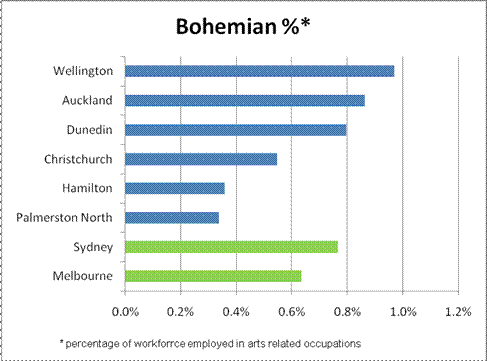Creative heaven or crappy little trading post?
Auckland and Wellington enjoy a healthy rivalry for the mantle as the arts and creative capital of New Zealand. The tussle is not trivial. Both cities recognize that a vibrant arts and creative community is not just a nice to have but is essential for growing their economies.
The link between the creative arts and economic development, especially in the areas of high technology, was articulated by Professor Richard Florida during his time at the Carnegie Mellon University in the US. He challenged the notion that it is amenities and infrastructure that attract people to a city and argues that a vibrant artistic community is a necessary condition to attract talented people to fuel the knowledge economy.
Florida calculated a Bohemian Index for the 50 major cities in the US which measured the proportion of the workforce who are involved in creative and artistic pursuits. His analysis showed that there is a strong correlation between the proportion of Bohemians in a city and the strength of its high tech industry. Ten of the top 15 bohemian cities also number among the nation’s top 15 high technology areas.
His theory extends beyond just the arts. He sees a connection between a city’s level of tolerance for a range of people, its ethnic and social diversity, and its success in attracting talented people. According to Florida people in technology businesses are drawn to places known for diversity of thought and open-mindedness.
Florida shows that the relative size of a city’s gay population is positively and significantly associated with both the ability of a region to attract talent and to generate high-tech industry. He asserts that straight men and woman look for a visible gay community as an indication that a city is likely to be an exciting place to live.
Gays can be thought of as canaries of the knowledge economy because they signal a diverse and progressive environment that fosters the creative and innovation necessary for success in high tech industry says Florida. Not only does a high concentration of gays predict a high concentration of high-tech, they are also a predictor of its growth. Cities with high concentrations of gays in 1990 experienced rapid growth in their high tech industries during the following decade.
Florida also showed that areas with high concentrations of foreign born residents rank high as technology centres.
Florida’s research has important implications for New Zealand. We know that the growth of high tech industries such as information technology and biotechnology are crucial for our quest to lift our productivity and move back into the top half of the OECD wealth table. To retain and attract workers for these industries we need vibrant cities with a healthy creative class and open and tolerant attitudes.
The competition between Auckland and Wellington for the mantle of creative capital encourages both cities to lift their game. As the home of the Royal Ballet, State Opera and New Zealand Symphony Orchestra Wellingtonians love to claim the title for themselves. But Aucklanders would argue that their city has more cultural institutions than Wellington, more events and much bigger audiences.
Our own Bohemian measure shows that Wellington pips Auckland in the size of its creative class relative to its total workforce. About 1% of Wellington’s workforce is employed in creative occupations such as artists, musicians and film directors, compared with 0.9% of Auckland’s workforce. Both New Zealand cities have higher proportions than Sydney and Melbourne (see chart).
A larger proportion of Wellington’s workforce may be employed in creative pursuits but in absolute size Auckland leaves Wellington standing. Fewer than 2,000 people are employed in creative occupations in Wellington compared with more than 4,500 in Auckland. And Auckland is a far greater magnet for immigrants. About 40% of Auckland’s population is foreign born compared with 25% in the capital city.
Auckland has outperformed Wellington in attracting highly skilled jobs over the past decade. During the current decade Auckland has been able to significantly grow the proportion of its jobs which are located in knowledge intensive industries whereas Wellington has been treading water. This would tend to support the northern city’s claim to be the cultural hub if Florida’s theories are indeed true.
Although Christchurch lags behind the other two major cities in the bohemian and foreign born measures it has also invested considerable resources in its creative sector. It has a working theatre, opera, a symphony orchestra and shiny new art gallery. Sir Gil Simpson, the founder of Jade Software Corporation, has spoken about the 'cultural infrastructure’ that made it possible for him to get skilled people to work at the end of the earth in Christchurch. He is quoted in an Auckland City Council report: "If you don’t take care to nurture and where necessary support a cultural sector, you’re just a shitty little trading post at the bottom of the Pacific."















